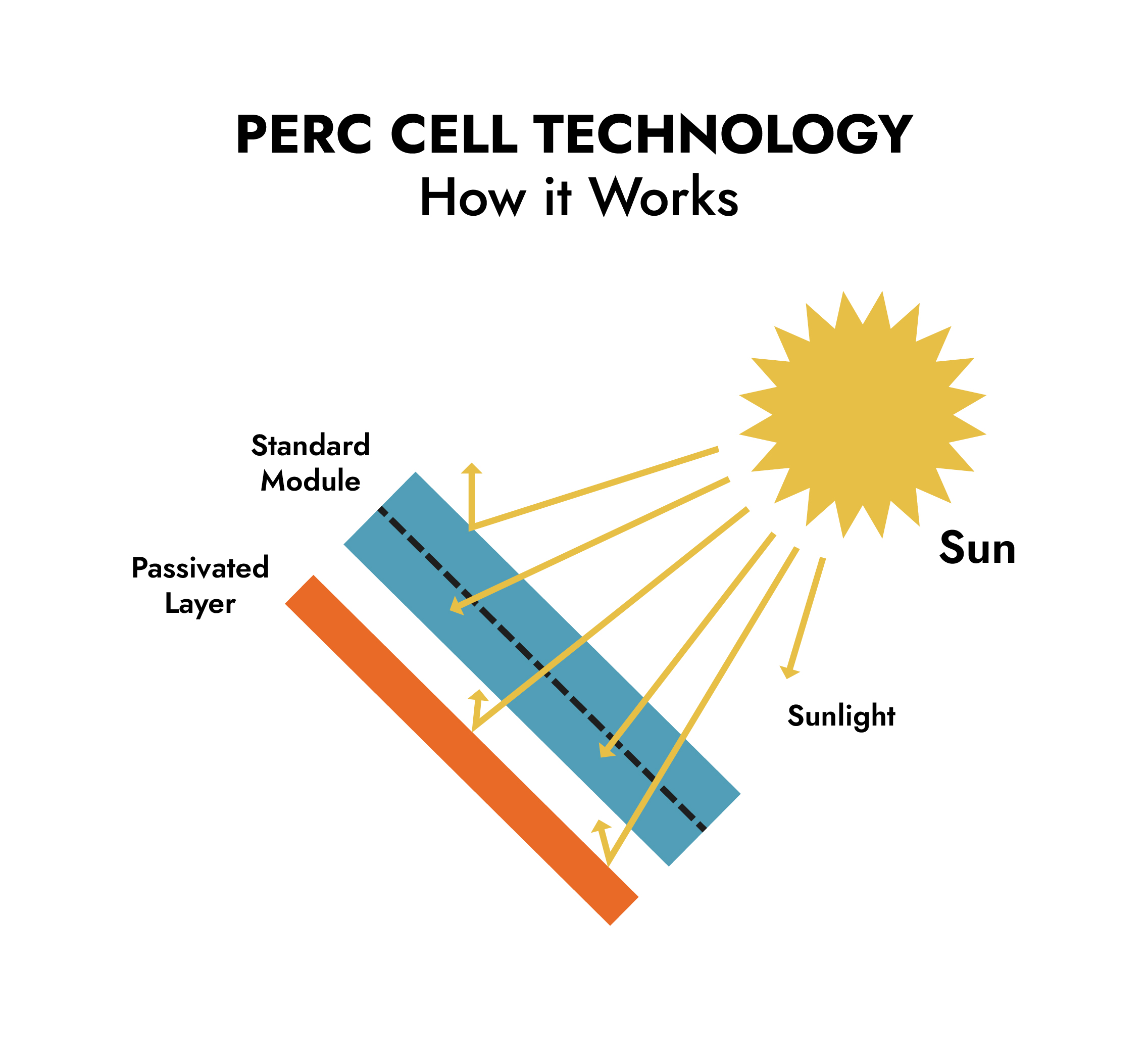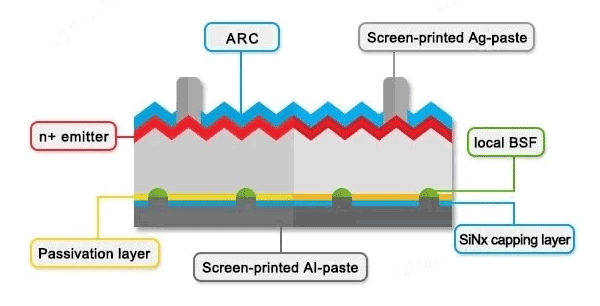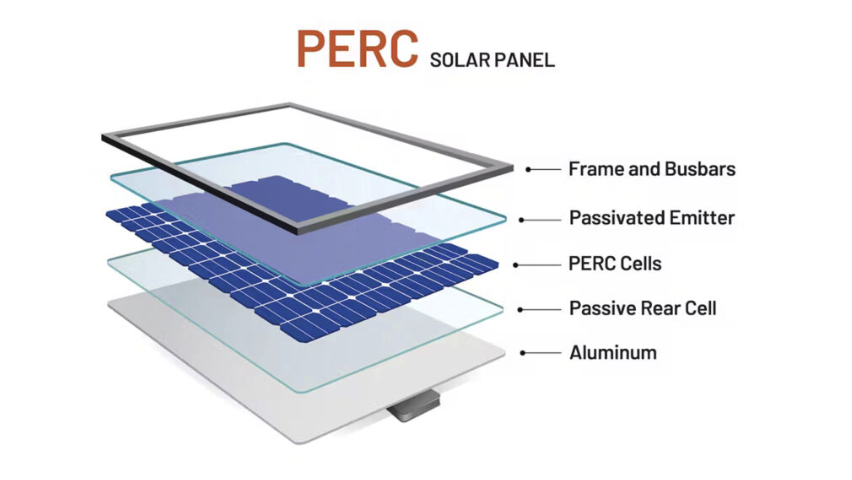Are you looking for a more efficient and cost-effective solar energy solution? Look no further than PERC (Passivated Emitter and Rear Cell) technology, the game-changer in the world of solar cells. This innovative technology has taken the solar industry by storm, offering unparalleled benefits for both residential and commercial applications. In this article, we’ll dive deep into the workings of PERC cells, explore their advantages, and discover how they are revolutionizing the solar energy landscape.
How PERC Technology Works
At the heart of PERC technology lies a simple yet ingenious modification to the traditional solar cell structure. By adding a passivation layer to the rear side of the cell, PERC technology effectively addresses two critical issues: light reflection and electron recombination.

Passivated Emitter and Rear Cell Structure
In a conventional solar cell, a significant portion of the incoming light is reflected back from the rear surface, reducing the cell’s overall efficiency. PERC cells tackle this problem by introducing a dielectric passivation layer, typically made of aluminum oxide (Al2O3) or silicon nitride (SiNx), on the rear side of the cell. This passivation layer acts as a reflector, bouncing the unabsorbed light back into the cell for a second chance at absorption.

The passivation layer in PERC cells also plays a crucial role in suppressing electron recombination. In traditional cells, electrons generated near the rear surface often recombine with holes before they can be collected, resulting in power losses. The passivation layer in PERC cells effectively reduces this recombination by creating a barrier that keeps electrons and holes apart, allowing more electrons to be collected and converted into usable electricity.

Suppressing Light Reflection and Electron Recombination
By minimizing light reflection and electron recombination losses, PERC cells can convert a greater portion of the incoming sunlight into usable electricity. This innovative design has enabled PERC cells to achieve higher conversion efficiencies compared to traditional solar cells, making them a superior choice for solar energy applications.
The Multiple Advantages of PERC Cells
The innovative design of PERC cells brings forth a host of advantages that make them a superior choice for solar energy applications.
Outstanding Conversion Efficiency
One of the most significant benefits of PERC technology is its ability to achieve higher conversion efficiencies compared to traditional solar cells. In fact, PERC cells have demonstrated efficiencies exceeding 22% in mass production, surpassing the performance of conventional aluminum back surface field (Al-BSF) cells. This outstanding efficiency translates into more power generated per unit area, making PERC cells an ideal choice for both residential and commercial solar installations.
Excellent Low-Light Performance
Another remarkable feature of PERC cells is their outstanding performance under low-light conditions. Thanks to the enhanced light capture enabled by the rear passivation layer, PERC cells can generate more electricity even when the sun isn’t shining at its brightest. This makes them particularly well-suited for regions with cloudy or overcast weather, as well as for applications where shading is a concern, such as in solar landscape lights.
Cost-Effectiveness and Value for Money
Despite their superior performance, PERC cells have become increasingly cost-competitive in recent years. As the technology has matured and manufacturing processes have been optimized, the cost of producing PERC cells has significantly decreased. This has made PERC technology an attractive option for solar energy projects of all scales, offering excellent value for money and faster returns on investment.
Applications of PERC Technology
The versatility and performance advantages of PERC cells have made them a popular choice across various solar energy applications.
Residential Rooftop Solar Systems
PERC technology has become a go-to solution for residential rooftop solar installations. The higher efficiency and improved low-light performance of PERC cells allow homeowners to generate more electricity from their limited roof space, maximizing their energy savings and reducing their reliance on the grid. When combined with innovative solutions like solar tubes, PERC cells can help homeowners harness the power of the sun more effectively than ever before.
Commercial and Industrial Distributed Solar Power Plants
In the commercial and industrial sectors, PERC cells are increasingly being adopted for distributed solar power plants. The enhanced performance and cost-effectiveness of PERC technology make it an ideal choice for businesses looking to reduce their energy costs and improve their sustainability credentials. From solar panels in Orlando to installations across the country, PERC cells are driving the growth of commercial solar energy.
PERC vs. Other Advanced Cell Technologies
While PERC technology has taken center stage in the solar industry, it’s worth comparing it to other advanced cell technologies to understand its relative strengths and limitations.
Interdigitated Back Contact (IBC) Cells
IBC cells are another high-efficiency solar cell technology that places both the positive and negative contacts on the rear side of the cell. While IBC cells can achieve even higher efficiencies than PERC cells, they are generally more complex and expensive to manufacture, limiting their widespread adoption.
Heterojunction (HJT) Cells
HJT cells combine the benefits of crystalline silicon and amorphous silicon to achieve high efficiencies and excellent temperature coefficients. However, the manufacturing process for HJT cells is more intricate and requires specialized equipment, making them less cost-competitive compared to PERC cells.
The Future of PERC Technology
As PERC technology continues to evolve and mature, it is poised to play an even greater role in the future of solar energy.
Integration with Bifacial and Tandem Cell Technologies
One exciting development is the integration of PERC technology with other advanced cell concepts, such as bifacial and tandem cells. By combining the benefits of PERC with the ability to capture light from both sides of the cell (bifacial) or to stack multiple cell layers with different bandgaps (tandem), researchers are pushing the boundaries of solar cell efficiency even further. This integration could lead to the development of ultra-high-efficiency solar panels that can generate even more power from the same surface area.
Pushing the Efficiency Limits
As research and development efforts continue, PERC technology is expected to break new efficiency records in the coming years. With ongoing optimizations in cell design, materials, and manufacturing processes, it is not unrealistic to expect PERC cells to surpass the 30% efficiency milestone in the near future. This would represent a significant leap forward in solar cell performance, making solar energy an even more compelling choice for a wide range of applications.
In conclusion, PERC technology has emerged as a revolutionary breakthrough in the world of solar cells, offering unmatched efficiency, performance, and cost-effectiveness. As the solar industry continues to evolve and grow, PERC cells are set to play a pivotal role in driving the transition to clean, sustainable energy. Whether you’re a homeowner looking to reduce your energy bills with the best Arlo Pro/Ring solar panel alternatives or a business aiming to minimize your carbon footprint, PERC technology is a smart and reliable choice for harnessing the power of the sun.